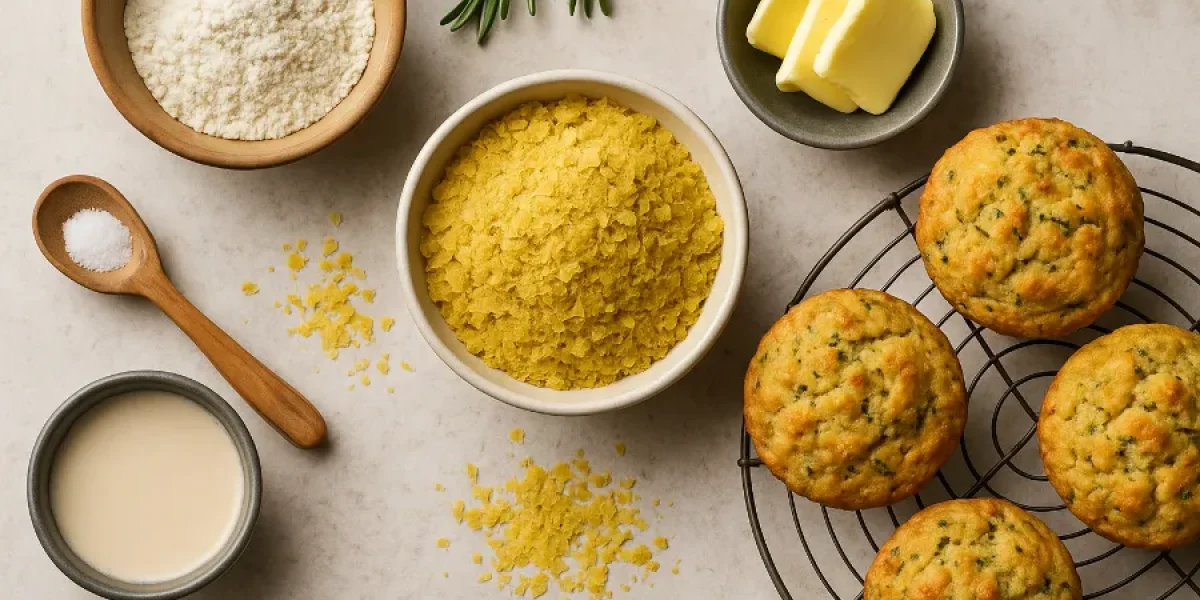Every baker has a secret ingredient that changes everything. For some, it’s browned butter. For others, flaky sea salt. But for me, it’s nutritional yeast a golden powder that smells faintly like toasted nuts and parmesan. The first time I stirred it into biscuit dough, my kitchen filled with a rich, comforting aroma that reminded me of cheese scones straight from a bakery oven. That moment started a quiet obsession with nutritional yeast recipes, especially when it comes to baking with nutritional yeast for savory flavor.
Baking has always been about balance: sweetness against salt, softness against crunch. But nutritional yeast introduces something more mysterious—umami. It deepens flavor the way sunlight warms color, making everything taste more complete. Whether you’re baking a rustic loaf at home or testing a fine-dining bread menu, this single ingredient bridges the gap between comfort food and gourmet finesse.
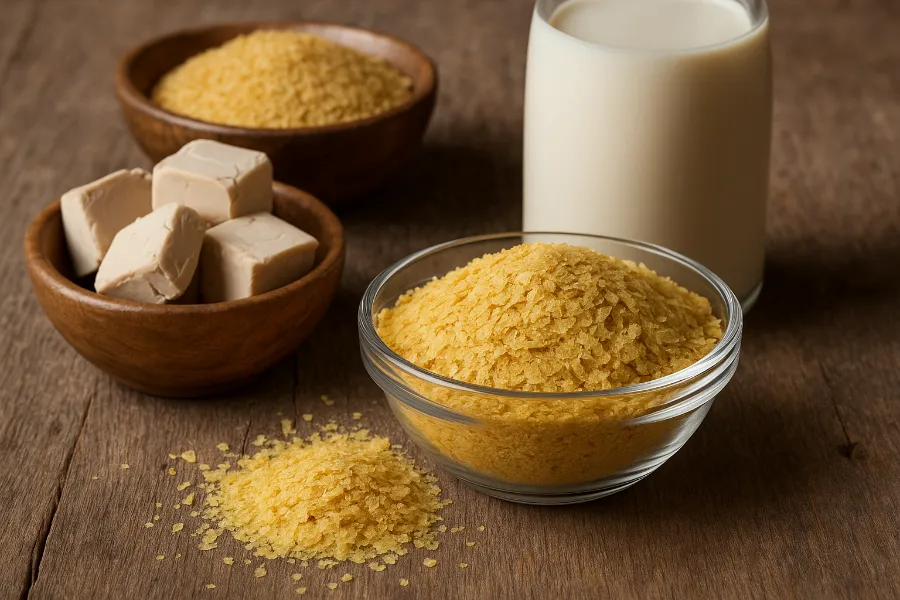
Where Nutritional Yeast Comes From
Despite its rise in popularity among modern cooks, nutritional yeast has humble, scientific roots. It comes from Saccharomyces cerevisiae, the same yeast species that gives bread its rise and beer its bubbles. But in this case, the yeast is deactivated through heat, removing its ability to ferment. What remains is pure flavor and nutrition—a flaky, golden seasoning full of amino acids and B-vitamins.
Producers grow it on sugarcane or beet molasses before pasteurizing and drying it into delicate flakes. These flakes have a naturally cheesy aroma and a buttery finish, making them a go-to ingredient for vegans who miss the richness of dairy. Today, you can find both fortified nutritional yeast—with added vitamin B12, iron, and folate—and unfortified varieties that rely solely on natural nutrients. The flavor difference is subtle: fortified yeast tends to taste a bit deeper and saltier, while the unfortified kind leans nuttier and lighter. When stored properly in a cool, dry jar, nutritional yeast keeps for up to two years. That longevity means you can sprinkle it over popcorn one day, stir it into soup the next, and bake it into your favorite bread recipe on the weekend without worrying about waste.
Nutritional Yeast for Vegans
For anyone eating plant-based, nutritional yeast for vegans is like gold dust. It delivers nutrients that are often hard to find in vegan diets—especially vitamin B12 and complete plant-based protein—but its real gift is flavor. It gives vegetables a roasted backbone, makes sauces taste aged and complex, and transforms bland grains into something cozy and satisfying.
I like to think of it as a flavor language. Vegans use it where non-vegans would reach for butter, cream, or cheese. A tablespoon in mashed potatoes replaces a knob of butter; a few spoonfuls in a béchamel sauce creates the illusion of melted cheddar. In baking, it lends doughs a savory depth that perfectly balances herbs and spices. Even if you’re not vegan, nutritional yeast deserves a spot in your pantry. It’s one of those ingredients that quietly makes everything better—like salt, but smarter.
Understanding Umami in Nutritional Yeast
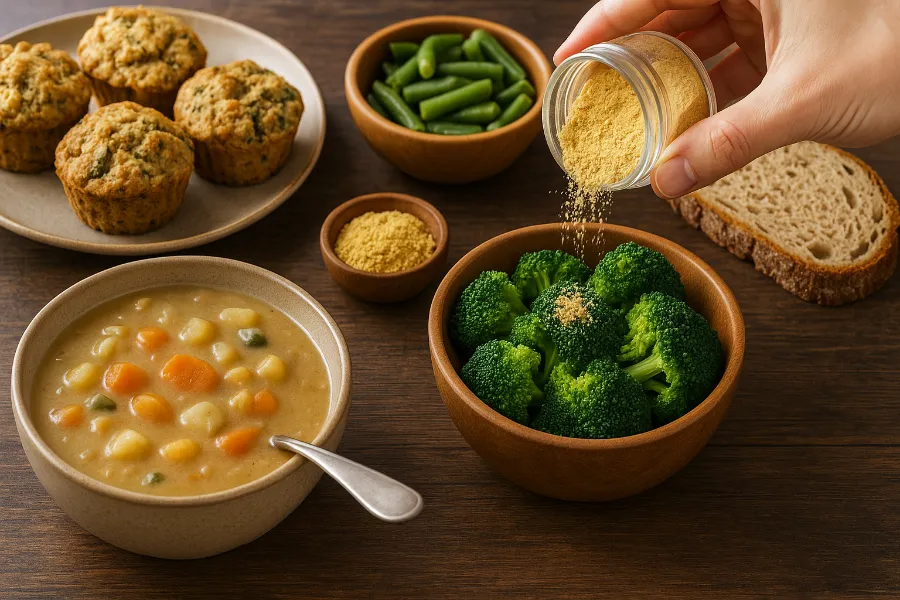
When food writers talk about umami, they’re describing a taste that’s savory, rounded, and deeply satisfying. It’s the essence of mushrooms, soy sauce, miso, and aged cheese. Nutritional yeast captures that same quality in a vegan-friendly way because it contains natural glutamic acids that trigger the umami receptors on your tongue.
This is why nutritional yeast feels indulgent even when you’re baking something wholesome. A simple loaf of whole-grain bread becomes heartier. Crackers gain that addictive, can’t-stop-eating flavor. When heat hits those golden flakes, it releases toasted notes—part nutty, part cheesy, slightly earthy. That’s what makes it a secret weapon for bakers looking to add depth without heaviness. I sometimes toast a tablespoon of nutritional yeast in a dry skillet before adding it to my dough. The aroma fills the kitchen—warm, like buttered popcorn and toasted nuts. The science says I’m caramelizing amino acids; my taste buds say I’m creating magic.
Baking with Nutritional Yeast
When I first started baking with nutritional yeast, I expected it to behave like a spice. But it’s more like a seasoning and a flour additive in one—it affects both flavor and texture. Because it’s lightweight and full of natural umami, it enhances without overwhelming.
Here are some ways to integrate it into your baking routine:
- Whisk into dry ingredients. Add two to three tablespoons for every cup of flour. This works beautifully in biscuits, savory scones, or yeasted breads.
- Blend with fats. Mix nutritional yeast into melted butter, olive oil, or vegan margarine before folding into dough. The fat helps distribute its cheesy flavor evenly.
- Sprinkle after baking. A dusting on hot pastries creates a golden crust that’s aromatic and irresistibly savory.
- Pair with herbs and spices. Garlic, rosemary, smoked paprika, and thyme complement its nutty edge.
- Add late to batters and sauces. High heat can dull the flavor, so stir it in at the end when possible.
Once you learn its rhythm, you start adding it instinctively—like salt or pepper. Every recipe becomes an opportunity to layer flavor.
Best Nutritional Yeast Recipes for Home Bakers
Over the years, I’ve built a small library of nutritional yeast recipes that feel timeless. They’re simple enough for weekday baking yet flavorful enough for company. Each one highlights what nutritional yeast does best—turning ordinary ingredients into comfort food.
Cheesy Nutritional Yeast Crackers
These thin, crisp crackers are my go-to savory snack when I’m craving something crunchy but don’t want to reach for chips.
Ingredients
- 1 cup all-purpose or whole-wheat flour
- 3 tbsp nutritional yeast
- ½ tsp salt
- ½ tsp garlic powder
- ¼ cup olive oil
- ¼ cup water
Method
- Combine flour, nutritional yeast, and seasonings.
- Add olive oil and water; mix into a soft dough.
- Roll very thin—almost translucent—and cut into squares.
- Bake at 350°F (175°C) for about 15 minutes, until golden.
Sprinkle more nutritional yeast right after baking. The heat melts it slightly, creating a delicate, cheesy crust. They store beautifully in an airtight tin for up to a week—but honestly, they rarely last that long.
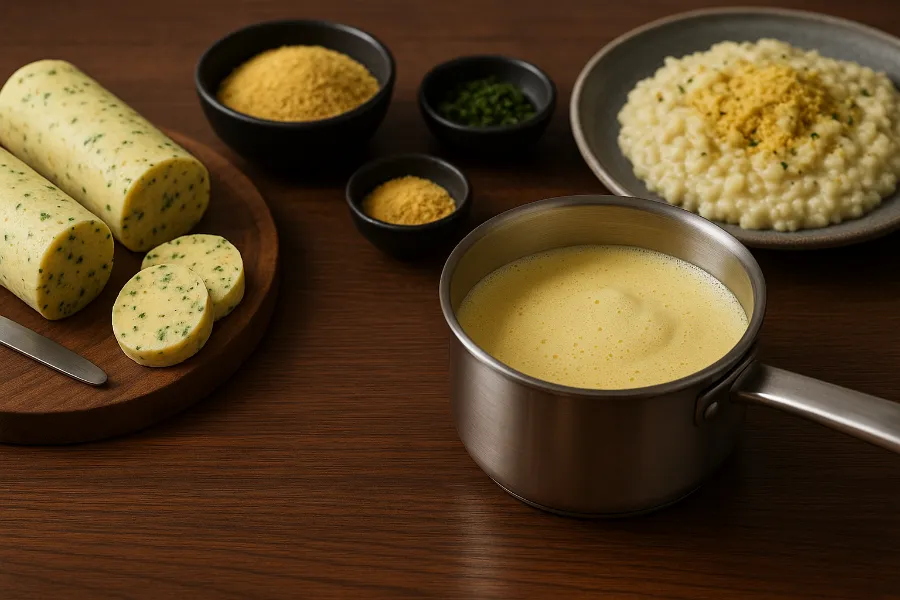
Flaky Nutritional Yeast Biscuits
If you’ve ever wished you could make cheddar biscuits without cheese, this recipe is for you.
Ingredients
- 2 cups all-purpose flour
- 3 tbsp nutritional yeast
- 2 tsp baking powder
- ½ tsp salt
- ½ cup cold butter or vegan butter
- ¾ cup plant milk with 1 tsp apple-cider vinegar
Directions
- Whisk dry ingredients together.
- Cut in butter until mixture resembles coarse crumbs.
- Pour in milk and stir until just combined.
- Drop onto a baking sheet and bake 12 minutes at 425°F (220°C).
They emerge golden, soft, and fragrant, tasting like something between a croissant and a cheese roll—airy yet deeply savory.
Nutritional Yeast Focaccia with Rosemary
This recipe never fails to impress guests. It’s a bread that smells like comfort itself.
Ingredients
- 3 cups bread flour
- 2 tbsp nutritional yeast
- 2 tsp salt
- 1 ¼ cups warm water
- 1 packet instant yeast
- ¼ cup olive oil
- Fresh rosemary
Steps
- Combine yeast and warm water. Let foam for five minutes.
- Add flour, nutritional yeast, and salt; mix into a soft dough.
- Knead until smooth, then let rise until doubled.
- Press into an oiled pan, dimple with fingers, drizzle oil, and top with rosemary.
- Bake 25 minutes at 400°F (200°C).
As it bakes, the nutritional yeast infuses the crust with nutty depth. Serve warm with olive oil and sea salt—pure perfection.
Savory Muffins with Nutritional Yeast
Sweet muffins get all the attention, but savory muffins deserve their own spotlight. Stir two tablespoons of nutritional yeast into your favorite base along with chopped herbs, olives, or sun-dried tomatoes. They’re wonderful for breakfast or as a side to soup. I often make a double batch and freeze them; a quick reheat brings back all the umami glory.
Nutritional Yeast Pie Crust
Add one or two tablespoons of nutritional yeast to your pastry flour before cutting in butter. It’s subtle, but once baked, your quiche or tart crust will have a warm, toasty flavor that complements any savory filling. Try it with roasted mushrooms and caramelized onions—it’s the kind of comfort that feels elegant enough for guests.
Savory Snacks Made with Nutritional Yeast
Beyond baking, nutritional yeast is my not-so-secret weapon for creating irresistible savory snacks. It’s amazing how a sprinkle can turn something simple into something you’d expect from a gourmet café.
- Popcorn: Toss hot popcorn with melted butter, nutritional yeast, and smoked paprika. It tastes like movie-theater popcorn that grew up.
- Roasted nuts: Warm almonds or cashews with olive oil and nutritional yeast until lightly toasted. Add thyme for a grown-up twist.
- Chickpeas: Roast canned chickpeas at 400°F with nooch and garlic powder until crisp.
- Avocado toast: A pinch of nutritional yeast on top adds cheesiness without the dairy.
- Kale chips: Massage kale leaves with olive oil and nutritional yeast, then bake until crisp and paper-thin.
Each bite proves that healthy doesn’t have to mean flavorless.
Fortified Nutritional Yeast: Why It Matters
If you’re browsing the baking aisle, you might notice both fortified and unfortified options. Fortified nutritional yeast includes added vitamins like B12, which can be tough to find in vegan diets. For everyday cooking, I tend to reach for fortified especially if I’m making dishes for friends who follow plant-based lifestyles.
That said, unfortified yeast shines when I want the purest, cleanest flavor. It’s slightly less salty, a little lighter, and beautiful in pastries or delicate batters. Think of it like choosing between salted and unsalted butter: both have their place.
Plant-Based Protein That Tastes Like Comfort Food
Every time I tell people that nutritional yeast is rich in plant-based protein, they look surprised. Each tablespoon offers about four grams of protein, along with all nine essential amino acids. It’s one of the few vegan ingredients considered a complete protein source.
This makes it perfect for baking because it enhances nutrition without changing texture. You can fold it into biscuit dough, pizza crust, or pancake batter, and no one will notice—except that your food suddenly tastes more satisfying. I often sneak it into family recipes; even the skeptics can’t deny the flavor.
Cheese Substitute Magic
There’s something playful about tricking the senses, and nutritional yeast does that effortlessly. It’s my favorite cheese substitute because it captures everything people love about cheese—the nuttiness, the depth, the slight tang—without the dairy.
You can whisk it into creamy sauces, blend it with cashews for vegan “cheese” spreads, or sprinkle it on lasagna before baking. In bread doughs, it mimics the warmth of aged cheddar; in pastry, it echoes Parmesan. It doesn’t melt, but it doesn’t need to—it delivers flavor instead of texture. That’s what makes it perfect for baking.
Baking for Vegans
Learning the art of baking for vegans changed the way I approach flavor. Without butter, milk, or cheese, you start seeking alternatives that feel indulgent yet stay plant-based. Nutritional yeast fills that void beautifully.
It adds personality to basic batters:
- A spoonful in pancake mix makes them taste like breakfast at a boutique café.
- Stirred into pizza dough, it brings a hint of pizzeria magic.
- Brushed on garlic knots with vegan butter, it creates a glossy, aromatic finish.
- Mixed into cornbread, it turns an everyday side into something extraordinary.
Once you start baking with it, you realize vegan recipes don’t have to chase after dairy—they can stand proudly on their own.
How Chefs Use Nutritional Yeast in Fine Dining
In professional kitchens, nutritional yeast has evolved from a “health food store ingredient” to a chef’s tool for precision flavoring. Fine-dining chefs love its umami depth and versatility.
Here’s how it shows up behind the scenes:
- Compound butters: Blended with herbs to brush onto breads or vegetables for service.
- Dusts and powders: Dehydrated and finely ground for a finishing touch on risotto or pastry.
- Laminated doughs: Folded between croissant layers for an invisible, toasty flavor line.
- Foams and sauces: Whisked into emulsions to build body without cream.
It’s remarkable to see the same ingredient that seasons home popcorn also appearing on restaurant tasting menus. That’s the beauty of nutritional yeast—it democratizes flavor.
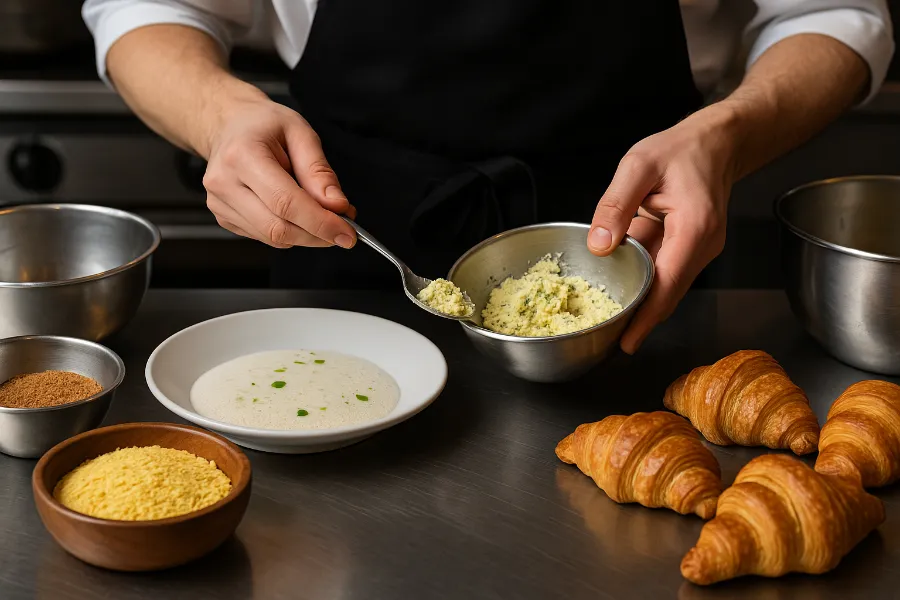
How I Use Nutritional Yeast Every Day
Even when I’m not baking, I reach for that jar constantly. A pinch in soup can wake it up. A sprinkle over steamed vegetables adds instant luxury. A teaspoon stirred into gravy or stew gives slow-cooked depth in minutes.
Sometimes I even dust it over toast with olive oil and cracked pepper—a minimalist snack that somehow feels indulgent. Once you understand its versatility, you stop seeing nutritional yeast as a substitute and start seeing it as its own category of flavor.
Tips for Storing Nutritional Yeast
To keep that savory magic intact:
- Store it in airtight containers away from sunlight.
- Scoop only with dry utensils.
- Keep it cool and moisture-free—pantries, not fridges.
- Replace every 18–24 months to keep flavors bright.
These little flakes deserve the same care you’d give to your best spices. The fresher they stay, the more umami payoff you’ll get in your baking.
Why Nutritional Yeast Belongs in Every Kitchen
By now, you’ve probably realized why I can’t stop talking about this ingredient. Nutritional yeast bridges two worlds—the cozy comfort of home baking and the refined creativity of restaurant cooking. It’s both humble and sophisticated, both nutritious and indulgent. Every time I bake with it, I’m reminded that real flavor doesn’t need to rely on dairy, or even on tradition. Sometimes, all it takes is a spoonful of golden flakes to turn flour, fat, and salt into something layered and memorable.
So here’s my gentle nudge: the next time you’re craving warmth, depth, and a touch of culinary adventure, open a jar of nooch. Bake a loaf, whisk a batter, or just sprinkle some over dinner. Because once you’ve discovered the art of baking with nutritional yeast for savory flavor, there’s no going back—you’ll never look at bread, biscuits, or even buttered popcorn the same way again.
FAQs
Nutritional yeast brings nutty, cheesy, and umami-rich depth to recipes. It enhances savory flavor naturally without dairy or artificial additives.
Yes! It’s a perfect cheese substitute for sauces, toppings, and doughs. While it won’t melt, it provides a similar flavor profile to aged cheese.
Fortified versions have added B-vitamins like B12, while unfortified yeast contains only natural nutrients. Both taste similar and work the same in baking.
Absolutely. It’s a staple in vegan diets because it’s dairy-free, rich in plant-based protein, and often fortified with essential vitamins.
Start with 2–3 tablespoons per cup of flour. This balance gives noticeable flavor without overpowering the other ingredients.
It adds umami that savory, satisfying depth found in cheese, mushrooms, and roasted foods. It’s warm, nutty, and slightly buttery.
Yes, in moderation. It adds a toasty background flavor to cornbread, savory muffins, or multi-grain pancakes without making them taste cheesy.

